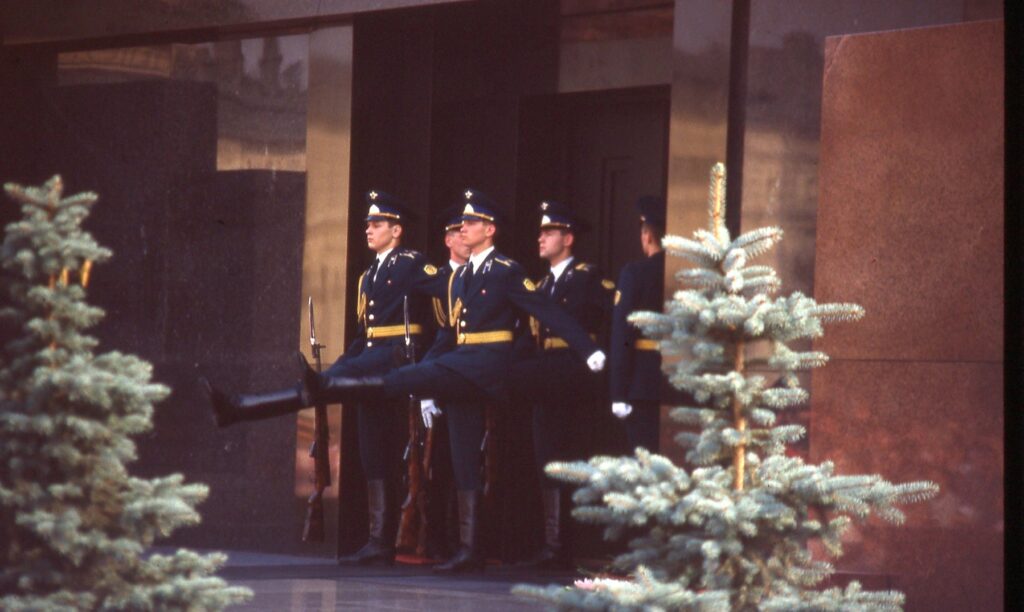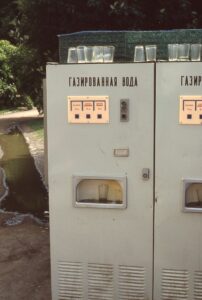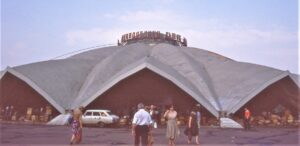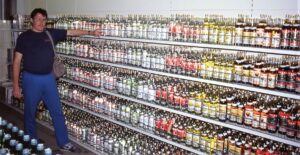
Previously: 40 Years in Beer, Part Nineteen: Moscow skyline in twilight, 1989.
Founding Soviet patriarch Vladimir Ilyich Lenin died in early 1924, and while he apparently wished to be buried over in the family plot, the needs of the living Bolsheviks far outweighed those of the dead.
His successors, shortly to be preoccupied with the reptilian power struggle that ended with Stalin’s fateful emergence, deemed Lenin’s corpse a potentially valuable marketing tool, an icon worthy of preservation by means of a miraculous ad hoc method of hitherto unknown embalming as soon to be put on display in a modernistic mausoleum by the Kremlin wall, facing Red Square.
Generations of Soviet citizens subsequently made a quasi-religious pilgrimage to view Lenin, and since the collapse of the USSR in 1992 this rite of passage has continued to be an option for new-age Russians, if not to its previous level of enforced devotion and decorum.
Visiting westerners irreverently referred to Lenin’s mausoleum as the Red Square Wax Museum, prompting our roving band of “students” to join the lengthy queue one day in July, 1989, enduring the humorless instructions of the mausoleum’s many uniformed handlers (no cameras, no gum, no tank tops or gym shorts, and absolutely no fun) in order to catch the briefest of glimpses at Communism’s official mummy.
Predictably, the comrade appeared waxen.

But near the mausoleum in a garden-like setting with the Kremlin wall again serving as backdrop was the Tomb of the Unknown Soldier, complete with an eternal flame and the names of Soviet “hero cities,” as dedicated to the millions of citizens, soldiers as well as civilians, who died in World War II.
It was and remains dignified and respectful, a very different and more honest pilgrimage. Irrespective of one’s views about Lenin, Stalin and communism, the USSR absorbed the heaviest share of punishment on the way to whipping the Nazis, making it all the more sad and infuriating to watch today as tsarist wannabe Vladimir Putin brutally inverts this lesson in the Ukraine.
All in all, Moscow in 1989 was an amazing place to visit, especially when residing in a genuine neighborhood as opposed to a sterile hotel. In that year Mikhail Gorbachev’s efforts to reform the Soviet system didn’t yet seem completely improbable, although optimism probably already had peaked. Before the year was out, the East Bloc abruptly collapsed, leaving the USSR to stumble forward to its own untidy demise in 1992.
—
There were many interesting reasons to visit the Soviet Union—history, culture, art and architecture among them—but beer didn’t rank very highly unless one’s travel itinerary focused on the periphery, places closer to Germany and Czechoslovakia, like the Baltic Republics (Estonia, Latvia and Lithuania) and westernmost Ukraine and Byelorussia, the latter now independent Belarus.
Not that beer was non-existent in Moscow.

One afternoon my fellow truants joined me for a visit to the Zhiguli beer hall (also one of the best known brands of golden lager) in one of several modern “showplace of socialism” buildings lining Kalininsky Prospekt (now New Arbat Street), just west of Red Square. The only reason I knew Zhiguli even existed was Michael “Beer Hunter” Jackson’s mention in his New World Guide to Beer.
Unfortunately there is no surviving personal documentation apart from an exterior view. My recollection is of steps leading to a fairly sizeable room with décor closer to the timeless porcelain- and stainless-steel White Castle motif than anything like the rustically Bavarian shtick into which the hall was later remodeled.
I think there was counter service for a single golden lager and an appetizer option of salted and/or smoked fish, with single digit rubles sufficing to settle entire bar tabs.
As noted previously, a couple of blocks up Shabolovka Street from our dorm was a combination produce shop and package store. It became a daily destination, although only within a four-hour afternoon window, the only time the alcohol vendor was permitted to open owing to Gorbachev’s universally unpopular campaign to combat alcoholism.
As with Stalin before him during an abbreviated period in the 1930s, Gorbachev learned the hard way that tax revenues from vodka sales were considerable, and therefore indispensable.
To put it mildly, the produce shop was not the place to seek the ingredients for a casual evening charcuterie, or for that matter, to purchase edibles of any sort. In fairness, the modernistic domed market hall a short distance away had food aplenty, as it was one of the designated legal sales points for collective farmers, whose tiny side plots were responsible for a disproportionately huge percentage of the USSR’s produce. Unfortunately we didn’t have kitchen facilities.

The items available for purchase at the liquor store changed daily, at least when the shelves were stocked at all. In the morning a truck brought beverages, or it didn’t, and if wares didn’t arrive, the employees sat impassively behind the counter and waited for their four-hour shifts to end.
One day there’d be vodka (the queue extending into the street was a dead giveaway), and the next wine. Twice there was beer. Two bottles of Armenian brandy always could be seen on the top-most shelf, appropriate placement given their price, which was far too high for neighborhood pocketbooks.
Of course as foreigners, we had options commensurate with our hard currency. Beriozka shops were scattered throughout the city, offering western goods at higher than normal prices—and please, keep those worthless rubles to yourself. In 1989 I was at last sufficiently prosperous to have a credit card, and cans of Carlsberg Export, Tuborg Gold and DAB from the Beriozka were lighter to lug than bottles. I’m not even sure Russian breweries had cans at this juncture.
We soon learned why beer seldom made it to customers at the shops, because cases of bottles could be reliably found at the taxis-only parking area just around the corner from Oktober Square. If you asked the nearest chain-smoking drivers for “pivo,” they’d motion you to properly stocked brethren, who’d pop their trunks to reveal black market export-only Soviet lager.
Not great beer but a fine deal, cheaper than imports at the Beriozka, and if taxi rank shoppers desired cosmetics, hand tools or auto parts with their beer, certain of the cabbies had those items for sale, too.
Beer produced according the Western European model came late to Russia, in the 1800s, but kvas (or kvass) has been a facet of Russian cuisine for more than a thousand years. Widely available from street vendors, only barely alcoholic and mildly carbonated brownish-hued kvas proved to be a deceptively effective thirst quencher in summer, and we stopped often during our ramblings to indulge.

Kvas is a tradition homebrewed drink in Russia, the Baltic and parts of Eastern Europe. It is made from brown or black bread, which is soaked in water, seeded with yeast (other additions, like raisins, honey or mint, vary from recipe to recipe) and left to ferment for a few days, a process that creates slight natural carbonation, and to greater or lesser extent, sourness.
No account of travel in the USSR during the 1980s would be complete without mentioning the jarring (to Western eyes) simplicity of Soviet-style vending machines.
While Moscow at decade’s end was the most modern region of the country, the old “shared cup” ways very much persisted.

The vending machines were rectangular gray boxes, usually with just one word stenciled on the front: “Voda” (drinking water).
There was a coin slot, and a posted price of one or two kopecks, at 100 kopecks to a ruble. The two choices were still (uncarbonated) or sparkling water. Public drinking glasses were available for use, and the machines came with a rinsing jet, although it helped to select the cleanest looking glass from the start. You placed it in the recess, deposited coins, pushed the button, drank the liquid, and set the glass back on the ledge for the next user.
These devices terrified most Americans, and so I utilized them at every opportunity (with fingers crossed).
—
Tour groups in the USSR usually had purely ambivalent hotel food included in the price of admission to the workers’ paradise. However, my group was staying in a dormitory, not a hotel. Provision was made for midday meals at the classroom facility, and once during the first few days of language instruction, before I decided to detach from the program and embrace self-catering, I turned a corner and found the director of Volunteers for Peace in a corridor brandishing cash and haggling with university officials over the cost of these meals.
As our pack of Moscow at-large ne’er-do-wells coalesced, foraging for sustenance and alcoholic lubrication became a daily task. The aforementioned market hall and shashlik kiosk in the Shabolovska neighborhood were reliable options, as well as a newly established hard currency bistro in the center (alas the name and exact location escape me).
We also dined on occasion at the sort of egalitarian cafeterias I’d patronized so often while traveling in the other Warsaw Pact nations. In the USSR they were called “stolovaya” (dining room table), and most often served items like pelmeni and pierogi (or verenyky in Ukrainian), various dumplings served in mystery sauce.
“Sit down for a nice meal” restaurants were comparatively thin on the ground in Moscow, numbering maybe one hundred in a city populated by millions. They were a considerable splurge for ordinary Soviet citizens, who might see the inside of one only when invited to a wedding banquet or party congress.
 Hospitality outlets and consumer-oriented food and drink simply weren’t prioritized apart from workplaces, where canteens and shops made up the shortfall. For visitors, this atypical reality was manifested in a received travelers’ wisdom, whereby Soviet restaurant entryways invariably were locked and closely guarded by grim minders, who’d point to the signs that indicated the eatery was completely reserved even when a glance through the window revealed vast Siberian-like emptiness.
Hospitality outlets and consumer-oriented food and drink simply weren’t prioritized apart from workplaces, where canteens and shops made up the shortfall. For visitors, this atypical reality was manifested in a received travelers’ wisdom, whereby Soviet restaurant entryways invariably were locked and closely guarded by grim minders, who’d point to the signs that indicated the eatery was completely reserved even when a glance through the window revealed vast Siberian-like emptiness.
But bribe these doormen with dollars, Marlboros or Crest toothpaste, and magically access would be granted—if they liked your looks. Ironically, it was during the 1989 journey to the USSR, my last before communism’s collapse, when it finally emerged that one could legitimately phone a restaurant in the morning and make reservations for the evening, and be escorted inside somewhat courteously, absent all the drama.
Clad in our jeans and t-shirts, we resolved one evening to air it out at the literal top of Moscow’s restaurant heap: the 21st floor eatery at the Hotel Rossiya, which had 3,182 rooms and was once the world’s largest hotel, since gratefully demolished, where diners could enjoy a spectacular bird’s eye view of the Kremlin and Red Square.
The reservations lesson having not yet sunk in, we haggled with the obstinate doorman, who eventually made a phone call and collected ten dollars each from the five of us. We were shown in, and for our $50, served appetizers, soup, an entrée and dessert, with unlimited bottles of wine, champagne and mineral water.
The meal lasted at least three hours, all of them spent at a table ringed with Indian national flags, with placards indicating that we were India’s delegation to some manner of international film festival being held at the Rossiya that weekend.
As with all the other restaurant meals I experienced in Moscow and Leningrad, what stands out in my mind is the “zakuski”, appetizers both hot and cold, often featuring pickled and smoked vegetables, cheese and fish.
These tidbits often were characterized by saltiness and tartness. According to Russian writer Alexander Genis, “the sour is the taste of Russia—everything is supposed to be sour for Russian taste. Like sour cream, for example, or pickled cucumber. Cabbage, mushroom.”

The practice of zakuski apparently originated among the landowning classes as a reflection of Russia’s vastness, and a mutually beneficial obligation to provide hospitality to travelers. In short, cured snacks and vodka were kept at the ready. These would sustain tired visitors until the slumbering kitchen could be animated to produce a full meal.
Restaurant-grade zakuski served a similar purpose. Diners were given ample time to graze the zakuski and empty their bottles before the indifferent entree finally appeared, usually only after diners were so far into their cups that any belly mortar was acceptable, unless it was rejected in favor of more vodka. There’d usually be dessert, often ice cream, which invariably was brilliant.
My globetrotting cousin has a wonderful story about his Moscow restaurant meal in the 1970s, which unfolded adjacent to a table occupied by two heavy drinking Russian men who obviously were Communist Party officials, judging by their jowly attitudes and stodgy 1950s-era suits.
When their huge bowls of ice cream appeared following enough vodka to stun an elephant, one of the men promptly passed out, face down, straight into his ice cream.
The other one shrugged, reaching across the table to save his friend from drowning in dessert by grabbing a patch of thinning hair and removing the hair’s head from the bowl, depositing the head with dripping ice cream onto the table, then continuing to eat his own ice cream between gulps of the bottle’s last dregs.
—
When it came time to leave Moscow in late July, many of my fellow students (most of whom I barely knew) joined flights arranged by Volunteers for Peace, which also helped with train tickets. I was one of a small group bound for West Berlin, and we needed to obtain Polish transit visas on our own, necessitating an outing to the Polish embassy.
We arrived to find a block-long line (and Moscow city blocks are huge), comprised of Soviet and Warsaw Pact citizens, as well as a great many foreign students from socialist countries like Cuba, Ethiopia and Vietnam seeking to take advantage of summer break at their universities. There was no choice, so we resolved to wait. Every now and then the line would inch forward, followed by a long period of motionlessness.
Finally a pair of English-speaking African students asked if we were Americans, and receiving affirmation, advised us to walk to the very front of the line and ask (in English) to be allowed to skip the queue and enter. Determined to be egalitarian and avoid ugly Americanism, we thanked them and stood our ground—and kept standing. After another 30 minutes, the Africans again shooed us toward the front, and so we went.
The Polish military guards saw our passports and grinned, seemingly delighted to see their long-lost friends. We were hastily admitted and processed within minutes.
It was a valuable lesson about imperialism, and how it runs in both directions, then as now.
Next: 40 Years in Beer, Part Twenty-One: Those legendary working beers with the FDJ in the GDR.
















































[…] Next: 40 Years in Beer, Part Twenty: Beer, zakuski, vodka and ice cream. […]
[…] Previously: 40 Years in Beer, Part Twenty: Beer, zakuski, vodka and ice cream. […]
Comments are closed.